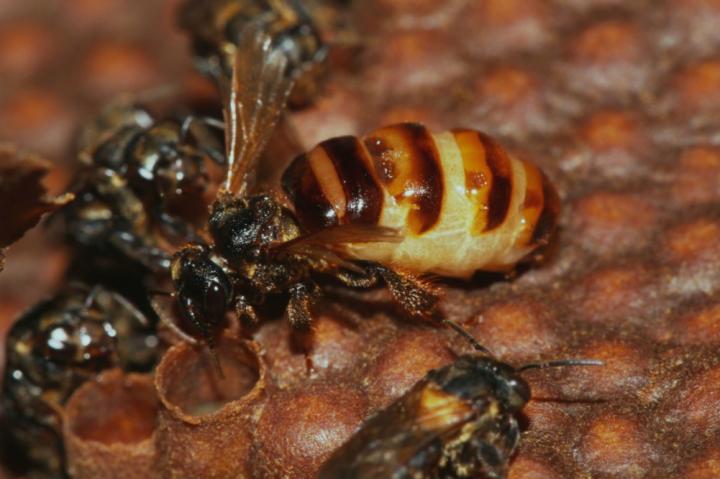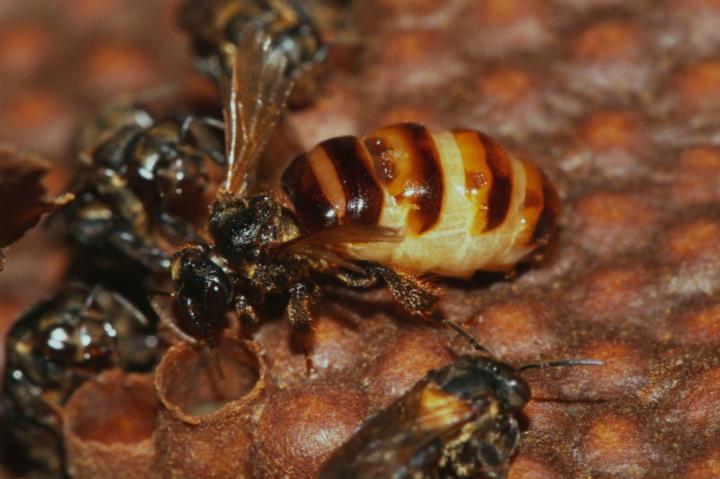
Credit: Ayrton Vollet-Neto / University of São Paulo
Queens of stingless bee species (Meliponini) face a reproductive dilemma. If they mate with males with which they turn out to share the same sex determination gene, half of their offspring will consist of males, and the colony's workforce will fall by half, given that effectively only the females are workers.
In addition, males with both paternal and maternal (diploid) genetic material as a result of this unfortunate choice by the queen only consume the resources collected by workers and are usually sterile, contributing to diminished reproductive chances for the colony.
A research project supported by the São Paulo Research Foundation (FAPESP) involving a team of scientists in universities of Brazil, Belgium, and the United Kingdom shows that the emergence of diploid males from this type of mating also leads to the death of the queen in colonies of the stingless bee species Scaptotrigona depilis.
According to Ayrton Vollet-Neto, first author of the study, the results suggest that this behavior may be common to all stingless bee species because it occurs in phylogenetically distant genera.
One possible explanation for the death of a queen which doesn't comply with the role of maintaining a proportional rate of worker bees in the colony is that a replacement daughter queen will be able to mate and ensure the colony's survival. Otherwise, the most probable outcome would be the death of the colony.
"If the queen is killed quickly, she can be replaced by a daughter that will have a chance to mate with a male that doesn't have the same sex allele," Vollet-Neto said.
The results of the study have been published in the Journal of Chemical Ecology.
Genetic accident damages male prole control
Vollet-Neto explains that female stingless bees are able to choose the sex of their offspring, a trait that they share with all insects in the order Hymenoptera, which include ants and wasps as well as bees.
Stingless bee queens mate only once in their entire lives. This happens when they are very young. They store sperm in the spermatheca, an organ located in the abdomen. In fertilizing ova with spermatozoa from the spermatheca, they generate diploid females, which have two copies of each gene (one from each parent) in their cells.
When queens want to produce males, they close a canal in the spermatheca to prevent the eggs from being fertilized. Haploid males (with only maternal genes) hatch from unfertilized eggs.
"Insects in the order Hymenoptera differ from other insects and from humans with regard to sex determination because males have no father and hatch from unfertilized eggs," Vollet-Neto said.
However, the sex determination mechanism in stingless bees can fail. By an unlucky chance, the queen may mate with a male whose genetic makeup will lead to the production of diploid males instead of females, he explained.
The reason is that sex determination in Hymenoptera is typically controlled by a complementary sex determination (CSD) gene, which may or may not has two alleles (copies). Moreover, if there are two alleles, they may be identical or different. If there is only one allele, the result is a male. If there are two different alleles in a diploid male, the result is a female. If there are two identical alleles, the result is another diploid male instead of a female.
"When there are two identical copies of the CSD gene, the insect's physiology interprets it as having only one. This results in a diploid male," Vollet-Neto explained.
"Male stench" triggers riot in the colony
To remedy the problem created when the queen chooses a mate with the same sex allele, the workers of the honey bee Apis mellifera, for example, are able to detect and kill diploid male larvae early in their development. This avoids a waste of resources and time, which would be invested in rearing them with no return for the colony.
In the case of stingless bees, there is little evidence of such behavior. Workers do not have access to brood cells to eliminate immature diploid males because the cells are sealed after oviposition and contain all the resources required by larvae to develop.
To test the hypothesis that stingless bees also have ways of remedying the consequences of diploid male production, the researchers performed an experiment in which they removed queens from colonies of S. depilis where diploid males were about to hatch and replaced them with "healthy" queens, which did not produce offspring with this trait.
The experiment showed that all the "healthy" queens introduced into the colonies where diploid males were about to emerge died within 10-20 days, whereas queens introduced into 20 control colonies without diploid male emergence did not die.
"These 'healthy' queens were not responsible for producing the diploid males that emerged in the colonies, so the conclusion we drew was that their death was determined by the emergence of diploid males," Vollet-Neto said.
Based on this finding, the researchers then tested the hypothesis that the cuticular hydrocarbon profiles of diploid males somehow served as a chemical signal for queen execution.
The cuticle is an extracellular layer that completely covers the external surface of social insects. Cuticular hydrocarbons act as a chemical signature for each individual in the colony.
To test their hypothesis, the researchers compared the chemical profiles of diploid and haploid males at zero, five and 10 days of age. Analysis using gas chromatography coupled with mass spectrometry showed that the cuticular hydrocarbon profile of diploid males differed significantly from that of haploid males as they grew older and that this occurred about 10 days after emergence – precisely when the queens began to die.
"This suggests male chemical profile differences may act as signals to trigger queen death," Vollet-Neto said. "But more research is needed to confirm or refute this hypothesis."
###
The project was carried out by researchers at the University of São Paulo (USP), Brazil, in cooperation with peers from the University of Leuven, Belgium, from the Instituto Tecnológico Vale (Belém State, Brazil) and from University of Sussex, United Kingdom.
Vollet-Neto did his Ph.D. research with a scholarship from FAPESP at USP's Ribeirão Preto School of Philosophy, Science & Letters (FFCLRP), with Professor Vera Lúcia Imperatriz-Fonseca as his supervisor.
About São Paulo Research Foundation (FAPESP)
The São Paulo Research Foundation (FAPESP) is a public institution with the mission of supporting scientific research in all fields of knowledge by awarding scholarships, fellowships, and grants to investigators linked with higher education and research institutions in the State of São Paulo, Brazil. FAPESP is aware that the very best research can only be done by working with the best researchers internationally. Therefore, it has established partnerships with funding agencies, higher education, private companies, and research organizations in other countries known for the quality of their research and has been encouraging scientists funded by its grants to further develop their international collaboration. For more information: http://www.fapesp.br/en.
Media Contact
Heitor Shimizu
[email protected]
55-113-838-4223
@AgencyFAPESP
http://www.fapesp.br
Original Source
http://agencia.fapesp.br/birth_of_undesirable_offspring_triggers_death_of_stingless_bee_queens/25958/





